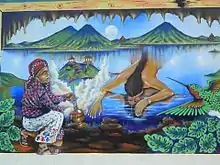San Juan La Laguna
San Juan La Laguna (Spanish pronunciation: [saŋ ˈxwan la laˈɣuna]) is a municipality on the southwest shore of Lago de Atitlán, Sololá, Guatemala. It consists of the village named San Juan La Laguna and three smaller aldeas (small villages) in the nearby mountain. The population is approximately 95% Tz'utujil. Agriculture is most important for the economy, with the service sector growing, especially as the number of tourists increase. The lowest elevation is the shore of Lago Atitlán at 1,562 metres (5,125 ft).
San Juan La Laguna
Xe' Kuku' Juyu' | |
|---|---|
Municipality and town | |
 San Juan La Laguna | |
 San Juan La Laguna location in Guatemala | |
| Coordinates: 14°42′N 91°17′W | |
| Country | |
| Department | |
| Government | |
| • Type | municipal |
| • Mayor | Antonio Chavajay Ixtamer |
| Area | |
| • Total | 3,718 km2 (1,436 sq mi) |
| Lowest elevation | 1,562 m (5,125 ft) |
| Population (2002) | |
| • Total | 10,177 |
| • Density | 27,372/km2 (70,890/sq mi) |
| Time zone | UTC-6 (Central Time) |
| Postal code | 07017 |
| Country calling code | 502 |
| Climate | Aw |



The town is notably less popular among tourists and expats, as a local law prohibits outsiders from purchasing land within the municipality. Due to this, visitors to the town can enjoy a more "authentic" experience among the indigenous T'zutujil population.
Local Economy
San Juan La Laguna is similar to other towns along the lake, in that its population has traditionally subsisted off of the income from the fishing and agriculture industries. Before tourism came to the town around a decade ago, the women would be forced to climb the surrounding mountains to sell their textiles to other communities.[1] Now, San Juan is home to Trama Textiles, a women's weaving co-op consisting of just over a dozen women who make textiles using the traditional Mayan art of backstrap loom weaving.[2] As of 2020, they have partners all over the world who sell their good wholesale, casting a wide net for their products and profit.[3]
The fishing industry has taken a hit in recent years, with the lake's fish population steadily declining. This is in part due to the introduction of the non-native Black Bass 1958 in an attempt to attract more recreational fishing tourism. It has since caused disruption of the lake's natural ecosystem, causing the extinction of local bird and fish species.[4] Most fishermen are still able to make a living by taking tourists out in their traditional boats, but worry about the future.[5] The main crops of the area are the typical include the typical avocado, coffee, cacao, and corn, though the town is notably lacking in land due to the expropriation of it by the government in response to the global coffee trade boom in the mid-20th century.[6]
Ethnic History
San Juan La Laguna is populated by an ethnic group called the Tz'utujil, one of 21 Maya ethnic groups. The Tz'utujil speak a language of the same name, Tz'utuijil, and share the coast of Lake Atitlán with another Maya ethnic group, the Kaqchikel. The Tz'utujil did not come to the region until the Late Postclassic period, during which they gained control of the entire lake. When the Kaqchikel arrived not long after, they were able to conquer some of the Tz'utujil territory due to their higher population numbers. In Pre-Columbian times, the Tz'utujil nation's capital was a town near Santiago Atitlán called Chuitinamit, which was conquered in 1523 by the Spanish conquistador, Pedro de Alvarado, with the help of the nearby Kaqchikel.[7]
Today, the people of Santiago Atitlán claim to be the only portion of the Tz'utujil to speak the pure form of the language, which they refer to as "Ktz'oj'bal." They claim that the townspeople of San Pedro La Laguna speak a dialect of Tz'utujil called "Pedrano," while the inhabitants of San Juan La Laguna speak "Juanero." [8]
Post-Civil War
The Guatemalan Civil War was fought between government forces and leftist rebels, the Revolutionary Organization of the People in Arms (ORPA) (Spanish: Organización Revolucionario del Pueblo en Armas). Spanning 36 years between 1960 and 1996, the war devastated the male population of Guatemala, leaving the women with few options to support themselves, their children, and the elderly. This is when the women's weaving cooperations of Guatemala sprouted into existence. San Juan hosts one such co-op, Trama Textiles, which employs just over a dozen women at any given time.
References
| Wikimedia Commons has media related to San Juan La Laguna. |
- Halperin, Eric. "Guatemala: Effect of Tourism in San Juan La Laguna". Pulitzer Center. Pulitzer Center. Retrieved 9 July 2020.
- "Backstrap Weaving". Maya Traditions Foundation. Maya Traditions Foundation. Retrieved 9 July 2020.
- "Trama Textiles". Trama Textiles. Shopify. Retrieved 9 July 2020.
- "Lake Atilán". Living Maya Time. Smithsonian Institution. Retrieved 07/09/2020. Check date values in:
|accessdate=(help) - Halperin, Eric. "Guatemala: Effect of Tourism in San Juan La Laguna". Pulitzer Center. Pulitzer Center. Retrieved 9 July 2020.
- "Lake Atitlán". Living Maya Time. Smithsonian Institute. Retrieved 9 July 2020.
